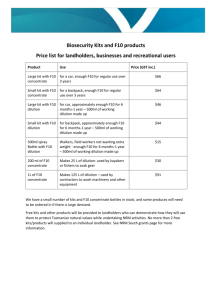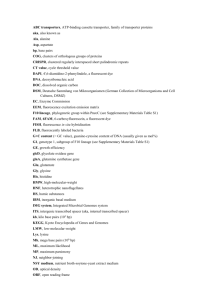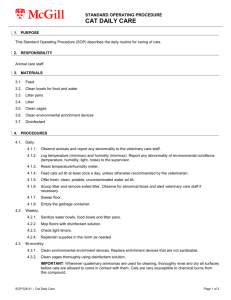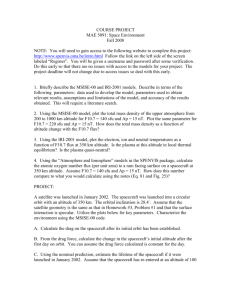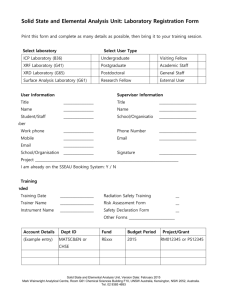F10UseinReptiles
advertisement
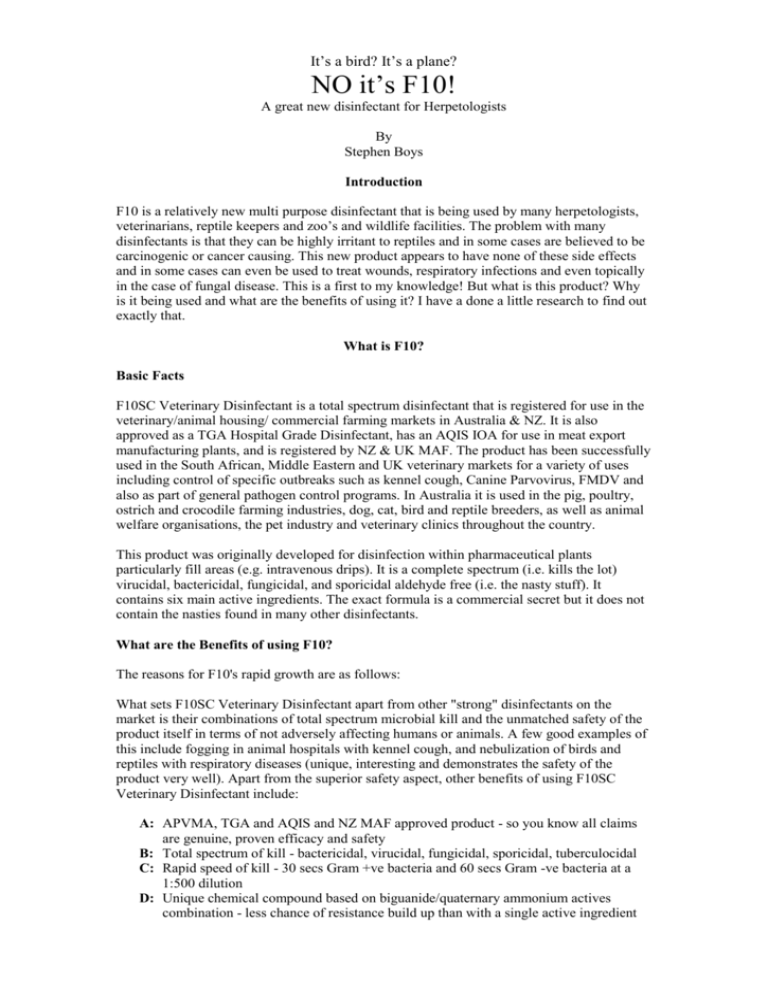
It’s a bird? It’s a plane? NO it’s F10! A great new disinfectant for Herpetologists By Stephen Boys Introduction F10 is a relatively new multi purpose disinfectant that is being used by many herpetologists, veterinarians, reptile keepers and zoo’s and wildlife facilities. The problem with many disinfectants is that they can be highly irritant to reptiles and in some cases are believed to be carcinogenic or cancer causing. This new product appears to have none of these side effects and in some cases can even be used to treat wounds, respiratory infections and even topically in the case of fungal disease. This is a first to my knowledge! But what is this product? Why is it being used and what are the benefits of using it? I have a done a little research to find out exactly that. What is F10? Basic Facts F10SC Veterinary Disinfectant is a total spectrum disinfectant that is registered for use in the veterinary/animal housing/ commercial farming markets in Australia & NZ. It is also approved as a TGA Hospital Grade Disinfectant, has an AQIS IOA for use in meat export manufacturing plants, and is registered by NZ & UK MAF. The product has been successfully used in the South African, Middle Eastern and UK veterinary markets for a variety of uses including control of specific outbreaks such as kennel cough, Canine Parvovirus, FMDV and also as part of general pathogen control programs. In Australia it is used in the pig, poultry, ostrich and crocodile farming industries, dog, cat, bird and reptile breeders, as well as animal welfare organisations, the pet industry and veterinary clinics throughout the country. This product was originally developed for disinfection within pharmaceutical plants particularly fill areas (e.g. intravenous drips). It is a complete spectrum (i.e. kills the lot) virucidal, bactericidal, fungicidal, and sporicidal aldehyde free (i.e. the nasty stuff). It contains six main active ingredients. The exact formula is a commercial secret but it does not contain the nasties found in many other disinfectants. What are the Benefits of using F10? The reasons for F10's rapid growth are as follows: What sets F10SC Veterinary Disinfectant apart from other "strong" disinfectants on the market is their combinations of total spectrum microbial kill and the unmatched safety of the product itself in terms of not adversely affecting humans or animals. A few good examples of this include fogging in animal hospitals with kennel cough, and nebulization of birds and reptiles with respiratory diseases (unique, interesting and demonstrates the safety of the product very well). Apart from the superior safety aspect, other benefits of using F10SC Veterinary Disinfectant include: A: APVMA, TGA and AQIS and NZ MAF approved product - so you know all claims are genuine, proven efficacy and safety B: Total spectrum of kill - bactericidal, virucidal, fungicidal, sporicidal, tuberculocidal C: Rapid speed of kill - 30 secs Gram +ve bacteria and 60 secs Gram -ve bacteria at a 1:500 dilution D: Unique chemical compound based on biguanide/quaternary ammonium actives combination - less chance of resistance build up than with a single active ingredient E: Cost effective - usage cost varies from 6c to 25c per diluted litre depending on concentration used. F: Non-corrosive, non-toxic, non-tainting, non-irritating, totally safe to handle and not hazardous G: Biodegradable and given an EU Ecological rating of "zero hazard" (so suitable for septic systems too) H: Highly effective at low concentrations I: No rinse off required after use - just apply and leave to dry J: Proven in a wide range of different veterinary situations, from clinics and hospitals to farming solutions and even direct animal treatment. From terminal and routine disinfection, to footbaths and hand-washes, our full product range (including hand soaps and skin treatment products) cover all veterinary, farming and animal housing disease control cleaning, disinfecting and personal hygiene requirements. As such, the F10 range is ideal for any reptile breeder's cleaning and disease control program, and also makes for a useful resale item in the 200ml pack size. To ensure we offer more than just a great product range, we also offer a range of chemical blending equipment to make dilution more accurate and simpler for users, as well as related equipment such as disinfection mats and fogging machines. A few cases of F10 Use in Reptiles Burn wounds in a python An African python received burn wounds from its heating element after the heater element cover was not replaced post cleaning. This resulted in a severe third degree burn to the caudal third of the body. A five-day course of the antibiotic ‘baytril’ was used, but the infection appeared to be drug resistant (Pseudomonas aeruginosa). In addition to another five course of baytril the wound was washed twice daily with F10 at a 1:250 concentration. The whole cage also was cleaned with F10 at each washing. After day ten the baytril was discontinued with the only method of treatment being the wound/cage washing with F10.After four weeks healthy granulation of the injured tissue occurred and the patient made a full recovery. The owner of the snake is now using F10 for disinfection of all snake facilities and also in the prevention of skin and eye infections associated with skin shedding. Bacterial and fungal dermatitis and stomatitis (mouth rot) have virtually disappeared. Respiratory disease in reptiles This disease is commonly seen in reptiles and may take the form of both upper respiratory tract disease (URTD) and lower respiratory tract disease (LRTD). The frequency of these diseases appears to be related to poor husbandry and the anatomy of reptiles. Infectious agents implicated include parasites, bacteria’s, fungi and viruses. F10 was used in the following ways in reptiles: Nasal flush: in cases of upper respiratory tract disease in terrestrial tortoises F10 was used at a concentration of 1:250 as a nasal flush. 0.1ml is used in each nostril daily. Environmental conditions were adjusted where applicable. Most cases resolve in a few days though some cases persist with a permanent clear discharge. Nebulisation: in cases of upper respiratory tract disease in both snakes and chelonians. F10 was used at a concentration of 1:250 used once daily for 30 – 60 minutes. In general it has been used in addition to antibiotics, but in some cases snakes have been cured by nebulisation alone. Intra pneumonic: in some cases of lower respiratory tract disease in chelonians, internal pneumonic lesions have developed. In these instances a hole has been drilled into the carapace or upper shell and 0.2ml F10 delivered directly to the lesion at 1:250 concentration. This was provided once daily in addition to antibiotics and daily nebulisation. Transvaal Snake Park South Africa This facility has commented on using this product for many years (1997) and has found it an excellent antibacterial and disinfectant. Areas used include food prep kitchen, utensils, egg incubation room, nursery and cage cleaning. Micro monitoring was performed on a regular basis and demonstrated a distinct improvement. No physical impact to animals or staff was observed. Yellow Fungus Disease in Bearded Dragons A highly contagious disease occurring in bearded dragons, presenting itself with yellow crusty like sores. There is not a lot known about this disease, but there are possibly two different forms. These seem to either originate from lizards that have been previously treated with antibiotics or those lizards that have come directly in contact with soil. An article appearing in the December 2006 VHS Monitor investigated this disease thoroughly. After much experimentation the author found that F10 SC at a rate of 8ml per litre sprayed directly on the lizards body between 5 – 15 times per day. Housing was also treated with F10. I n additions to this, lizards were provided regular access to direct sunlight. The condition started to clear between 4 – 6 weeks later and the author continued oi treat them for an additional 2 weeks with no recurrence. In Conclusion This is the first disinfectant that I have seen to be ideal for herpetologists. Not only is it safe for the disinfection of housing and facilities, it also has potential to treat various ailments experienced by herps. F10 is currently not readily available in pet shops as yet. Although I am assured by suppliers, that you are able to buy it in small quantities from your veterinary surgeon. At $20 + or more for 200mls, it appears quite expensive in comparison to other disinfectants, but the advantages of safety to you and your herp far outweigh this. Also remember that once this product is diluted the price equates to about 25c a litre! Acknowledgements Thanks goes to Andrew Chalmers of Chemical Essentials Pty Ltd (The Australian F10 representative) for his assistance with product information. References 2006 December Moroz. R. Yellow fungus disease in bearded dragon VHS Monitor 1998 Morgan D.R. Letter to Health and Hygiene re F10 use Transvaal Snake Park South Africa Date unknown: Chitty.J.R. Strathmore Veterinary Clinic UK Use of a novel disinfectant Agent in reptile respiratory disease 2001Verwoerd. D. /Veterinarian Burn wounds in a python, complicated by pseudomonas Letter to Health and Hygiene re F10 use Further info is re F10 is also available at www.chemicalessentials.com.au or www.healthandhygiene.net.
